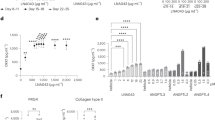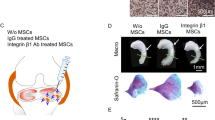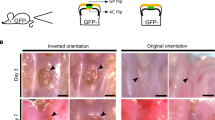Abstract
Combination of growth factor gene-enhanced cartilage matrix synthesis with interleukin-1 receptor antagonist protein (IL-1Ra) abrogation of cartilage matrix degradation may reduce and possibly reverse cartilage loss in synovitis and osteoarthritis. The feasibility of cotransduction of synovial membrane with two such genes that may act on cartilage homeostasis was investigated in an in vitro coculture system. Cultured synoviocytes in monolayer were cotransduced with E1-deleted adenoviral vectors, one containing IGF-I coding sequence under cytomegalovirus (CMV) promoter control (200 multiplicities of infection (moi)), and the second containing IL-1Ra sequence under CMV promoter control (100 moi). Adenovirus-IGF-I (AdIGF-I) transduction and AdIGF-I/AdIL-1Ra cotransduction of synovial monolayer cultures resulted in increased IGF-I mRNA and ligand expression, and similarly AdIL-1Ra and AdIGF-I/AdIL-1Ra-transduced cultures expressed high levels of IL-1Ra. Northern analysis confirmed a single mRNA transcript of the appropriate size for both IGF-I and IL-1Ra transgene expression. Synovial cell monolayer and cartilage explant coculture experiments were used to examine the effects of IGF-I and IL-1Ra protein expressed by transduced synoviocytes on normal and IL-1-depleted cartilage. Transduced monolayer cultures produced peak medium IGF-I content of 114±20.2 ng/ml and IL-1Ra levels of 241.8±10.5 ng/ml at 48 h after transduction. These IGF-I concentrations were sufficient to produce significantly increased proteoglycan (PG) content of normal cartilage cultured in medium conditioned by AdIGF-I and AdIGF-I/AdIL-1Ra-transduced synoviocytes. Interleukin-1-exposed cartilage was markedly depleted of PG, and this catabolic state was partially reversed in AdIGF-I-transduced cultures and fully reversed by AdIGF-I/AdIL-1Ra-transduced synovial cocultures. These data indicate that cultured synoviocytes are readily cotransduced by two recombinant adenoviral vectors containing transgenes active in restoring joint health. The AdIL-1Ra and AdIGF-I transgenes were abundantly expressed and the secreted products achieved therapeutic concentrations by day 2. The resulting increase in matrix biosynthesis returned cartilage PG content to normal levels. These data suggest that there may be significant value in cotransduction of synovial membrane to attenuate cartilage malacia associated with synovitis, injury, or early arthritis.
This is a preview of subscription content, access via your institution
Access options
Subscribe to this journal
Receive 12 print issues and online access
$259.00 per year
only $21.58 per issue
Buy this article
- Purchase on Springer Link
- Instant access to full article PDF
Prices may be subject to local taxes which are calculated during checkout







Similar content being viewed by others
References
Nixon AJ, Fortier LA, Williams J, Mohammed HO . Enhanced repair of extensive articular defects by insulin-like growth factor-I laden fibrin composites. J Orthop Res 1999; 17: 475–487.
Fortier LA, Lust G, Mohammed HO, Nixon AJ . Insulin-like growth factor-I enhances cell-based articular cartilage repair. J Bone Joint Surg 2002; 84-B: 276–288.
Saxer RA et al. Articular insulin-like growth factor-I therapy via adenoviral mediated gene transfer to the synovial lining. J Orthop Res 2001; 19: 759–767.
Bandara G et al. Intraarticular expression of biologically active interleukin 1-receptor-antagonist protein by ex vivo gene transfer. Proc Natl Acad Sci USA 1993; 90: 10764–10768.
Roessler BJ et al. Adenoviral-mediated gene transfer to rabbit synovium in vivo. J Clin Invest 1993; 92: 1085–1092.
Roessler BJ et al. Inhibition of interleukin-1-induced effects in synoviocytes transduced with the human IL-1 receptor antagonist cDNA using an adenoviral vector. Hum Gene Ther 1995; 6: 307–316.
Hung GL et al. Suppression of intra-articular responses to interleukin-1 by transfer of the interleukin-1 receptor antagonist gene to synovium. Gene Therapy 1994; 1: 64–69.
Pan RY et al. Therapy and prevention of arthritis by recombinant adeno-associated virus vector with delivery of interleukin-1 receptor antagonist. Arthritis Rheum 2000; 43: 289–297.
Huppertz HI . How could infectious agents hide in synovial cells? Possible mechanisms of persistent viral infection in a model for the etiopathogenesis of chronic arthritis. Rheumatol Int 1994; 14: 71–75.
Bresnihan B et al. Treatment of rheumatoid arthritis with recombinant human interleukin-1 receptor antagonist. Arthritis Rheum 1998; 41: 2196–2204.
Arend WP, Guthridge CJ . Biological role of interleukin 1 receptor antagonist isoforms. Ann Rheum Dis 2000; 59 (Suppl 1): i60–i64.
Berenbaum F et al. Insulin-like growth factors counteract the effect of interleukin 1 beta on type II phospholipase A2 expression and arachidonic acid release by rabbit articular chondrocytes. FEBS Lett 1994; 340: 51–55.
Brower-Toland BD et al. Direct adenovirus-mediated insulin-like growth factor-I gene transfer enhances transplant chondrocyte function. Hum Gene Ther 2001; 12: 117–129.
Fortier LA, Nixon AJ, Lust G . Phenotypic expression of equine articular chondrocytes grown in three-dimensional cultures supplemented with supraphysiologic concentrations of insulin-like growth factor-1. Am J Vet Res 2002; 63: 301–305.
Fortier LA, Lust G, Mohammed HO, Nixon AJ . Coordinate upregulation of cartilage matrix synthesis in fibrin cultures supplemented with exogenous insulin-like growth factor-I. J Orthop Res 1999; 17: 467–474.
Nixon AJ et al. Differentiated cellular function in fetal chondrocytes cultured with insulin-like growth factor-I and transforming growth factor-B. J Orthop Res 1998; 16: 531–541.
Jiang Y et al. A multicenter, double-blind, dose-ranging, randomized, placebo-controlled study of recombinant human interleukin-1 receptor antagonist in patients with rheumatoid arthritis: radiologic progression and correlation of Genant and Larsen scores. Arthritis Rheum 2000; 43: 1001–1009.
van Meurs JB et al. Interleukin-1 receptor antagonist prevents expression of the metalloproteinase-generated neoepitope VDIPEN in antigen-induced arthritis. Arthritis Rheum 1998; 41: 647–656.
Frisbie DD et al. Treatment of experimental equine osteoarthritis by in vivo delivery of the equine interleukin-1 receptor antagonist gene. Gene Therapy 2002; 9: 12–20.
Smith P et al. Genetic enhancement of matrix synthesis by articular chondrocytes: comparison of different growth factor genes in the presence and absence of interleukin-1. Arthritis Rheum 2000; 43: 1156–1164.
Arend WP, Dayer JM . Cytokines and cytokine inhibitors or antagonists in rheumatoid arthritis. Arthritis Rheum 1990; 33: 305–315.
Bird JLE, Wells T, Platt D, Bayliss MT . IL-1B induces the degradation of equine articular cartilage by a mechanism that is not mediated by nitric oxide. Biochem Biophys Res Comm 1997; 238: 81–85.
Frisbie DD, Nixon AJ . Insulin-like growth factor 1 and corticosteroid modulation of chondrocyte metabolic and mitogenic activities in interleukin 1-conditioned equine cartilage. Am J Vet Res 1997; 58: 524–530.
Hubbard JR, Steinberg JJ, Bednar MS, Sledge CB . Effect of purified human interleukin-1 on cartilage degradation. J Orthop Res 1988; 6: 180–187.
Hutchinson N et al. In vivo expression of stromelysin in synovium and cartilage of rabbits injected intraarticularly with interleukin-1B. Arthritis Rheum 1992; 35: 1227–1233.
MacDonald MH, Stover SM, Willits NH, Benton HP . Regulation of matrix metabolism in equine cartilage explant cultures by interleukin-1. Am J Vet Res 1992; 53: 2278–2285.
Morris EA, Treadwell BV . Effect of interleukin 1 on articular cartilage from young and aged horses and comparison with metabolism of osteoarthritic cartilage. Am J Vet Res 1994; 55: 138–145.
Abe M et al. Regulation of interleukin (IL)-1B gene transcription induced by IL-1B in rheumatoid synovial fibroblast-like cells, E11, transformed with simian virus 40 large T antigen. J Rheumatol 1997; 24: 420–429.
Joosten LAB, Helsen MMA, van den Berg WB . Transient chondrocyte nonresponsiveness to insulin-like growth factor-1 upon H2O2 exposure is not related to IGF receptor damage. J Rheumatol 1991; 18: 585–590.
van den Berg WB et al. Mechanisms of cartilage destruction in experimental arthritis: lack of IGF-1 responsiveness. In: Lewis AJ, Doherty NS, Ackerman NR (eds). Therapeutic Approaches to Inflammatory Diseases. Elsevier Science Publishing Co. Inc.: New York, 1989, pp 47–54.
Verschure PJ, Joosten LEO, van de Loo FAJ, van den Berg WB . IL-1 has no direct role in the IGF-1 non-responsive state during experimentally induced arthritis in mouse knee joints. Ann Rheum Dis 1995; 54: 976–982.
Schalkwijk J, Joosten LAB, van den Berg WB, van de Putte LBA . Chondrocyte nonresponsiveness to insulin-like growth factor 1 in experimental arthritis. Arthritis Rheum 1989; 32: 894–900.
Hardy S et al. Construction of adenovirus vectors through Cre-lox recombination. J Virol 1997; 71: 1842–1849.
Nixon AJ, Sandell LJ, Brower-Toland BD . Primary nucleotide structure of predominant and alternate splice forms of equine insulin-like growth factor-I and their gene expression patterns in tissues. Am J Vet Res 1999; 60: 1234–1241.
Balkman CE, Nixon AJ . Molecular cloning and cartilage gene expression of equine stromelysin 1 (matrix metalloproteinase 3). Am J Vet Res 1998; 59: 30–36.
Levine RA, Sendy M, Guo L, Holzschu D . Elongation factor Tu as a control gene for mRNA analysis of lung development and other differentiation and growth-regulated systems. Nucleic Acids Res 1993; 21: 4426.
Farndale RW, Buttle DJ, Barrett AJ . Improved quantitation and discrimination of sulphated glycosaminoglycans by use of dimethylmethylene blue. Biochem Biophys Acta 1986; 883: 173–177.
Acknowledgements
This study was funded by the Steadman Hawkins Sports Medicine Foundation. The histological processing was carried out by MaryLou Norman.
Author information
Authors and Affiliations
Rights and permissions
About this article
Cite this article
Nixon, A., Haupt, J., Frisbie, D. et al. Gene-mediated restoration of cartilage matrix by combination insulin-like growth factor-I/interleukin-1 receptor antagonist therapy. Gene Ther 12, 177–186 (2005). https://doi.org/10.1038/sj.gt.3302396
Received:
Accepted:
Published:
Issue Date:
DOI: https://doi.org/10.1038/sj.gt.3302396
Keywords
This article is cited by
-
Is clinical effect of autologous conditioned serum in spontaneously occurring equine articular lameness related to ACS cytokine profile?
BMC Veterinary Research (2020)
-
Current Applications of Growth Factors for Knee Cartilage Repair and Osteoarthritis Treatment
Current Reviews in Musculoskeletal Medicine (2020)
-
Use of Tissue Engineering Strategies to Repair Joint Tissues in Osteoarthritis: Viral Gene Transfer Approaches
Current Rheumatology Reports (2014)
-
Controlled Delivery Systems: From Pharmaceuticals to Cells and Genes
Pharmaceutical Research (2011)



